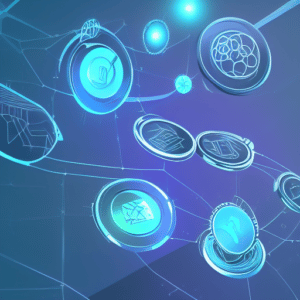In this beginner’s guide, we’ll introduce you to non-fungible tokens (NFTs) and explain how they work. We’ll also discuss some of the potential implications of NFTs to help illustrate how they can be put to practical use.
The Web3 Research Institute is reader-supported. When you buy through links on this site, we may earn a commission at no cost to you.
As blockchain technology evolves, so does the potential for new and innovative applications of the technology.
One such application is non-fungible tokens (NFTs). NFTs are unique digital assets that can be used to represent a wide variety of items, from collectible cards to digital art.
Although NFTs are gradually gaining popularity in the crypto community, they can be confusing for newbies. If you’re a beginner, keep reading this guide to learn everything you need to know about NFTs.
What Are NFTs?
NFTs are unique digital assets. This means that every NFT is different from all other NFTs. They are also stored on a blockchain, which makes them immutable and transparent.
Each NFT is like a snowflake: no two are exactly alike. NFTs can represent anything unique and not interchangeable—from digital art to collectibles to in-game items.
They are different from cryptocurrencies, which are fungible. This means that all cryptocurrency coins are worth the same. The most popular example is Bitcoin.
Why Are NFTs Important?
Beginners often wonder what advantages NFTs have over traditional assets.
Here are the key reasons why NFTs matter:
1. They’re more secure than physical assets because they’re stored on a blockchain.
2. They’re portable. You can carry them with you wherever you go without having to worry about losing them or them being stolen.
3. They’re divisible. You can own a fraction of an NFT just as easily as you can own an entire one.
4. They’re programmable. You can create smart contracts that will automatically execute when certain conditions are met.
How Are NFTs Used Today?
People use NFTs to represent a wide variety of assets, including digital art, collectibles, gaming items, and even real-world property.
Here are some examples of how NFTs are being used today:
Digital Art
NFTs have become a popular way to sell and trade digital art.
For example, the popular crypto art platform SuperRare allows artists to sell their works as NFTs. Collectors can then buy these works using cryptocurrency and trade them on secondary markets.
Collectibles
People are also using NFTs to create virtual collectibles.
For example, the popular crypto game CryptoKitties allows players to breed, buy, and sell virtual cats as NFTs.
You can also trade these virtual cats on secondary markets similar to how physical collectibles are traded.
The Potential Applications of Non-Fungible Tokens
The potential applications for NFTs are vast and varied. Let’s explore the potential applications of NFTs and how they might change the way we interact with digital art and gaming.
Digital Art
One potential application of NFTs is in the area of digital art.
With an NFT, artists can sell their artwork as a digital file that cannot be reproduced or duplicated. This allows artists to control the distribution of their work and can lead to a new market for digital art.
Gaming
Another potential application of NFTs is in the area of gaming.
In-game items that are purchased with real-world currency could be stored as NFTs on a blockchain.
This would allow people to own their items outright and could lead to a secondary market for in-game items.
Other Potential Applications of NFTs
While these are just two potential applications, NFTs clearly have the potential to revolutionize the way we interact with digital content and assets.
Only time will tell what other applications for NFTs will be developed in the future.
How Beginners Can Get Started with Using NFTs
The first step for beginners is to find a cryptocurrency exchange that supports NFT trading. Not all exchanges do, so it’s important to do your research before signing up for an account.
Once you’ve found an exchange that supports NFTs, you’ll need to deposit some funds into your account so that you can start trading.
Once you have funds available in your account, you can start looking for NFTs to buy. You can find NFTs being sold on various online marketplaces, such as OpenSea.
When considering which NFT to buy, please be sure to do your due diligence and research the item thoroughly before making a decision.
You’ll also want to be aware of the fees associated with buying and selling NFTs. Fees can vary depending on the exchange or marketplace you’re using.
Finally, once you’ve purchased an NFT, it’s important to store it securely. The most common way to do this is by using a cryptocurrency wallet that supports NFTs. Not all wallets do, so be sure to select one that does before transferring your NFT into it.
Once you safely store your NFT in your wallet, you can sit back and (hopefully) watch its value appreciate over time!
Final Thoughts
So there you have it! NFTs are a versatile technology that you can use in several different ways, from digital art and collectibles to video game items and property rights.
And with the adoption of NFTs on the rise, now is the perfect time to start learning about how they work and how you can use them.
So what are you waiting for? Check out the NFT resources from 101 Blockchains below to get ahead of the curve!
Related Articles

Starbucks and the Brave New World of Web3
Learn how Starbucks is leveraging the power of Web3 and non-fungible tokens (NFTs) to build its innovative Odyssey loyalty program.

6 Advantages of NFTs
This article explores the advantages of non-fungible tokens (NFTs). Find out how they are changing the landscape of digital asset ownership!

5 Disadvantages of NFTs
This article explores the disadvantages of NFTs and why they may not be ready for mainstream adoption yet.
